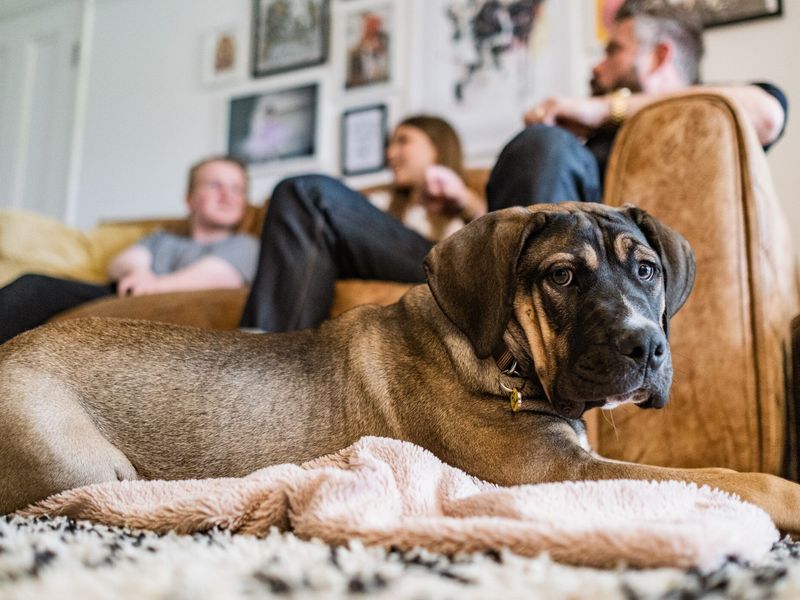How to keep your dog off the furniture
Are you a sofa sharer? Or would you prefer your dog to relax in their own space? We've advice for you either way.

You may love nothing more than snuggling up on the sofa with your pooch or letting them jump up on your bed in the morning. But, if you would prefer that they didn’t, then you may be wondering how to stop them from getting on your furniture.
Before we look at how to teach them to get off, here’s why they want to be on there.
Why dogs want to get on the furniture
When we purchase a sofa, we are looking for comfort as we are going to spend our time resting here. Dogs also appreciate that this is a comfortable space that they can rest on. Some dogs also see it as a way to interact with their owner.
So, remember, if you don’t want them on there, they are not doing it to be disobedient but rather because they see it as comfortable space or somewhere to spend time with you.
Do you want your dog on the furniture?
Whether you are happy for your dog to jump on and off it as they please, don’t want them up there at all, or only want them on the furniture when they are invited – consistency is key.
It’s important for all family members to be consistent, so dogs can easily learn what is OK and what isn’t.
If one family member always allows your dog up, one lets them up when invited and one never allows them up, this will get very confusing for your pup. This is why you should decide together what you are happy for your dog to do.
Dogs can easily get confused and worried when rules change for reasons they don’t understand. For example, if they are normally allowed on a sofa, but are told off if they jump up when they have muddy paws.
How to ask your dog to get off the sofa
Dogs are learning all the time and we want to help them learn what we would like them to do.
If you would like to ask your dog to get off the sofa you should:
- use something that your dog likes and enjoys such as food or a toy to lure them off the sofa
- reward them once they are off
- use your recall word to call them off the sofa and reward them when they come to you.
When your dog is off the sofa, ensure you engage them in an enjoyable activity or encourage them to settle in their own bed.
Avoid anything hands on such as using a collar, lead or harness to get your dog off the sofa. Dogs will be more comfortable and learn quicker when offered a reward for the desired behaviour.
Avoid telling your dog off for being on the sofa as this might make them feel worried.
You can add an on/off cue to your dog's repertoire.
Need to know: Dogs like to repeat behaviours that give them a good result, for example, jumping on the sofa gives them a comfy place to rest. When you’re teaching your dog to not jump on the sofa, access should be limited to prevent them from practising resting on the sofa when you are not around to supervise. Find out more about teaching your puppy good habits.
Sofa alternatives
It is important that dogs have a choice of their own comfortable resting areas as an alternative for the sofa. Their resting spots should be positive and safe spaces where they enjoy spending time.
You’ll need to help teach your dog where they can settle. This might be an appropriate dog bed, blankets or even a specific rug or mat. Encouraging your dog to settle in their own space will set them up for success because they’ll know where you want them to rest.
Teaching a dog to settle can also be beneficial when helping them cope alone and relax in the home environment.
Need to know: Dogs have different sleep patterns to humans. It’s important to leave them to sleep and not disturb them when they are. Disturbing a dog while they are sleeping or resting presents some risk, as this is a crucial time when dogs prefer to be left alone. Providing your dog with a comfortable, suitably sized bed away from potential disturbances to avoid them being startled in their sleep is a good option.
Use of blanket for furniture permission and visual cue
If you are happy for your dog to get on the sofa, then using a blanket can provide a clear sign to them that they have permission to join you.
Any blanket or towel could be used but should only be used for this activity and put away safely when not in use. It is beneficial to use the same blanket as this will help your dog remember what the specific blanket means.
This can be trained by placing the blanket on the floor first – and teaching your dog to settle on it. Then once your dog has the hang of this, you can progress to putting the blanket on the sofa so they can settle on there. Only put the blanket on the sofa when you’re happy for your dog to be on it.
The blanket can also be used in different environments, such as if you go on holiday or to a friend’s house. You can place the blanket on the sofa to allow your dog up or keep it on the floor for them to settle there instead.
Children and dogs on furniture
It is important that children learn to be considerate of their four-legged friends and know how to safely spend time with them, especially when they are close together on sofas and chairs.
Children must be taught:
- to leave dogs undisturbed when they are sleeping or resting anywhere in the house, including on sofas
- not to hug dogs (this includes both on and off the sofa)
- snuggling is a lovely way for them to connect but only if your dog has chosen to sit close to them or on their lap
- that your dog can choose whether they remain close to them or not – they must be free to move away at any time without being followed.
Never leave a child and dog together alone. No matter how used to dogs a child is – and vice versa – it is essential for an adult to be actively involved and closely supervising at all times when they are together.
Top tip: Understanding how dogs communicate with us, and responding appropriately, will help keep them and us safe. So, keep an eye on their body language and look out for signs of fear or anxiety.
Older dogs and sofa access
It’s important to remain mindful that a dog’s mobility is likely to change over the course of their lives. As they become elderly, they might not be able to continue to jump on or off furniture as easily or comfortably, which might cause distress.
It is important that dogs have their own comfy bed throughout their lives – even if they’re allowed to rest on furniture. This will help make it easier for them to adjust to only spend time in their beds, rather than on the sofa, as they become less agile.
You should have regular checks with your vet as you dog gets older and ensure you raise any concerns, particularly if you notice any changes in their mobility or behaviour.
Top tip: If you’re comfortable with your dog being on the sofa but they struggle to jump on due to their age, breed, size, or mobility, then consider getting them a small step or ramp to help them. Similarly, if your floor is slippery, a rug placed near the sofa might be useful. Your vet will be able to advise how you can best support your dog with any mobility or other health needs they have.
Contact our Behaviour Support Line
Need help with your dog’s training or behaviour? Contact our Behaviour Support Line for free expert advice.
Call us on 03030036666
or
Our free telephone service is open Monday to Friday 8.:30am to 7.:30pm and Saturday and bank holidays 9.:30am to 5pm.
Related articles



